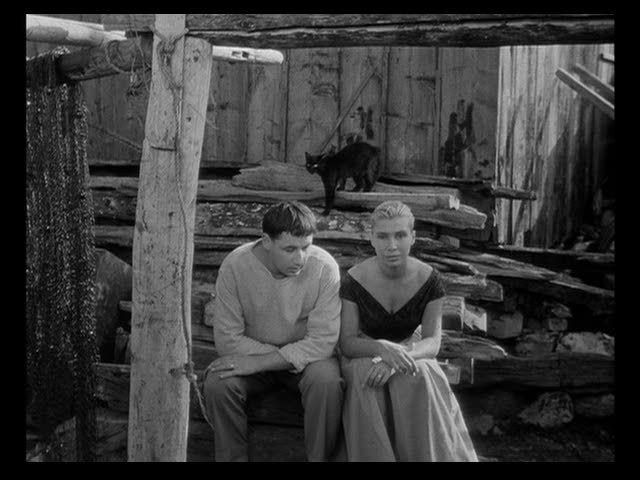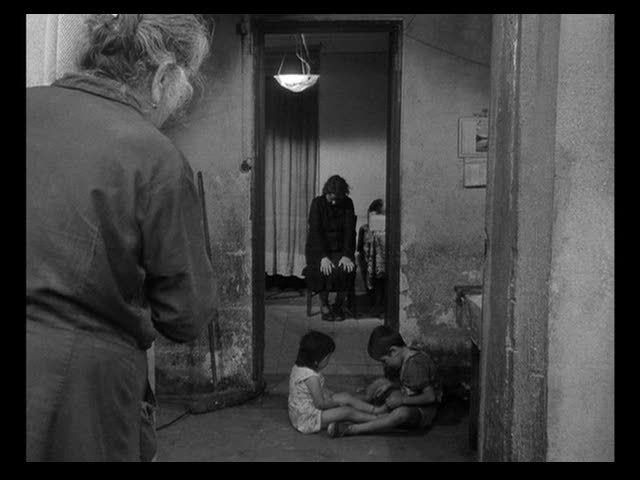
Agnès Varda's film career began with the quiet, neorealist poeticism of La Pointe-Courte, a loose, contemplative film that's equally about a couple whose marriage is in trouble, and the tiny rural fishing village where they go to vacation and work out their problems. Varda's central romantic couple is never the sole focus of the narrative. Rather, they seem to be wandering in and out of the action, meandering through the slow-moving fabric of life in the titular town. There are many other dramas to be found here: the travails of the local fishermen who must constantly butt heads with the health board over the quality of the town's shellfish output; the single woman whose promiscuity has saddled her with an unmanageable herd of kids; the developing romance between one of the local young men and the daughter of an ornery, disapproving fisherman. Other than the two leads, the rest of the cast is composed entirely of the real town's residents, giving the film its strong verité quality.
Varda's pace is leisurely, peeking in on these ordinary little stories, her camera drifting weightlessly through each scene. The graceful camerawork in this film is extraordinary, seeming to float and bob with the wind. There has seldom been a film that so evocatively captures the feeling of the air in its setting, the gentle sting of the constant winds whipping through this seaside village: maybe Malick's Days of Heaven, or the island breezes of I Walked With a Zombie. In the streets, dangling on thin lines, sheets billow in the wind, and Varda's camera is blown along with the breeze, caught up in its currents, quietly whistling through the town's nearly empty streets, shuffling into corners or gently drifting sideways to pan across a scene.
The camerawork is as relaxed and supple as the rhythms of life here, which is not to say that it is accidental. Rather, Varda maintains a tight control over her seemingly languid images, often offsetting the balloon-like floating of the camera with striking formalist compositions recalling the early films of Bergman and Antonioni, though Varda has always insisted that she was no cinephile and had seen hardly any films when she made this debut. If so, her instinctive eye for composition and motion is even more impressive, especially since there is nothing self-consciously showy about what she's doing. The camera always seems to be doing exactly what it should be to get the most out of a particular moment. At one point, the two lovers (Philippe Noiret and Silvia Monfort as the unnamed husband and wife) are framed in tight closeups with one's profile cutting across half of the other's face — an image that would later most famously appear in Bergman's Persona. Also remarkable is the scene in which a mother grieves for her dead little boy, and Varda's camera, framing the woman in a doorway, begins pulling back, creating another frame within a frame as it passes through yet another door. Outside, the women of the town begin gathering around this exterior door, finally blocking the mother's grief discreetly from voyeuristic view.

Though Varda has a light, subtle formalist's touch, the film is even more evocative in its less mannered moments, when the wandering camera mirrors the wandering of the young couple as they stroll through the town. The town is populated by cats, a visual echo of the teeming, active kittens of Vigo's L'Atalante, and Varda even gets some fun, improvisatory "performances" out of these tiny extras. At one point, while the couple sits on a bench, moodily exchanging hesitant abstractions about love — their favored activity throughout the film — a black kitten stirs from sleep on the crates stacked above their heads, stretches and yawns, walks around, and finally hisses at the girl before strolling off. It's just one small indication of Varda's ability to keep her images interesting by being open to the play of peripheral elements. At another point, as the lovers are walking together, Varda's camera begins roaming away from them, letting them disappear at the edges of the frame, focusing instead on the chopped lumber by the side of the road. In another scene, only the couple's feet are seen at the top of the frame, while Varda explores the textures of the sandy beach they're walking across.
It's apparent that Varda is not so much interested in telling a story as exploring a setting, probing the emotions awakened by a particular place. The young couple's romantic problems aren't actually that interesting, and they talk in such cold, analytical terms about their love that it's hard to really feel much for their arguments and reconciliation. They're opposed, in broad terms, as a dichotomy between the country boy (calm, tranquil, emotionally restrained) and the city girl (stormy, inconstant, fast-paced), but neither of them ever quite gets into the rhythms of this town over the course of their vacation. The boy identifies very strongly with this place, where he was born and still knows some people, but even he is oblivious to the small stories that Varda probes into, the everyday dramas of the fishermen and their families. He has left the town, and is now nearly as much of a visitor as his truly outsider wife. If a film this ambiguous and ephemeral can be said to have a point, it's to emphasize the extent to which one's life is tied to setting, the ways that a sense of place informs the character of life itself. Varda's film, more than anything, aims to capture that sense of place, to evoke the languid rhythms of this seaside life.

1 comment:
Ed - I just saw this for the 1st time, and it's pretty unique....and pretty brilliant. It's like a mash-up of Rossolini and Bergman, as strange as that sounds. The scene in the hull of the old boat looks like it could have been lifted right from "Through a Glass Darkly"...Except it predates the Bergman film.
Post a Comment